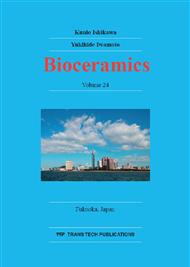p.161
p.167
p.173
p.178
p.183
p.187
p.192
p.197
p.202
In Vitro Evaluation of Chelate-Setting Cements Fabricated from Silicon-Containing Apatite Powder Using Osteoblastic Cells
Abstract:
In our previous study, silicon-containing hydroxyapatite (Si-HAp) powder was prepared via an aqueous precipitation reaction. The Si-HAp powders were synthesized with desired Si contents (0, 0.4, 0.8, 1.6, and 2.4 mass%) as a nominal composition. Another previous study in our group demonstrated surface-modification of HAp powder with inositol phosphate (IP6) enhanced the compressive strength of apatite cement. Thus, to fabricate the cements with higher bioactivity, the above Si-HAp powders were surface-modified with IP6 (IP6-Si-HAp). The IP6-Si-HAp cements with various Si contents were fabricated by mixing with pure water at the powder/liquid ratio of 1/0.4 [w/v]. In order to clarify biocompatibility of the IP6-Si-HAP cements in the present work, MC3T3-E1 cells as a model of osteoblast were seeded on the cement specimens. As for the numbers of cells cultured on the IP6-Si-HAp cements, the substitution of lower levels of Si into HAp lattice did not greatly influence the cell proliferation. However, the substitution of Si amount over 0.8 mass% enhanced the cell proliferation. Especially, the IP6-Si-HAp cement with the Si content of 2.4 mass% showed excellent cell proliferation among examined specimens. Therefore, to fabricate the cements with higher bioactivity, it is necessary to control the amount of Si in the IP6-Si-HAp cements. The usage of these IP6-Si-HAp cements may make it possible to fabricate the cements with higher bioactivity, compare to conventional pure HAp cements.
Info:
Periodical:
Pages:
183-186
Citation:
Online since:
November 2012
Keywords:
Price:
Сopyright:
© 2013 Trans Tech Publications Ltd. All Rights Reserved
Share:
Citation:


